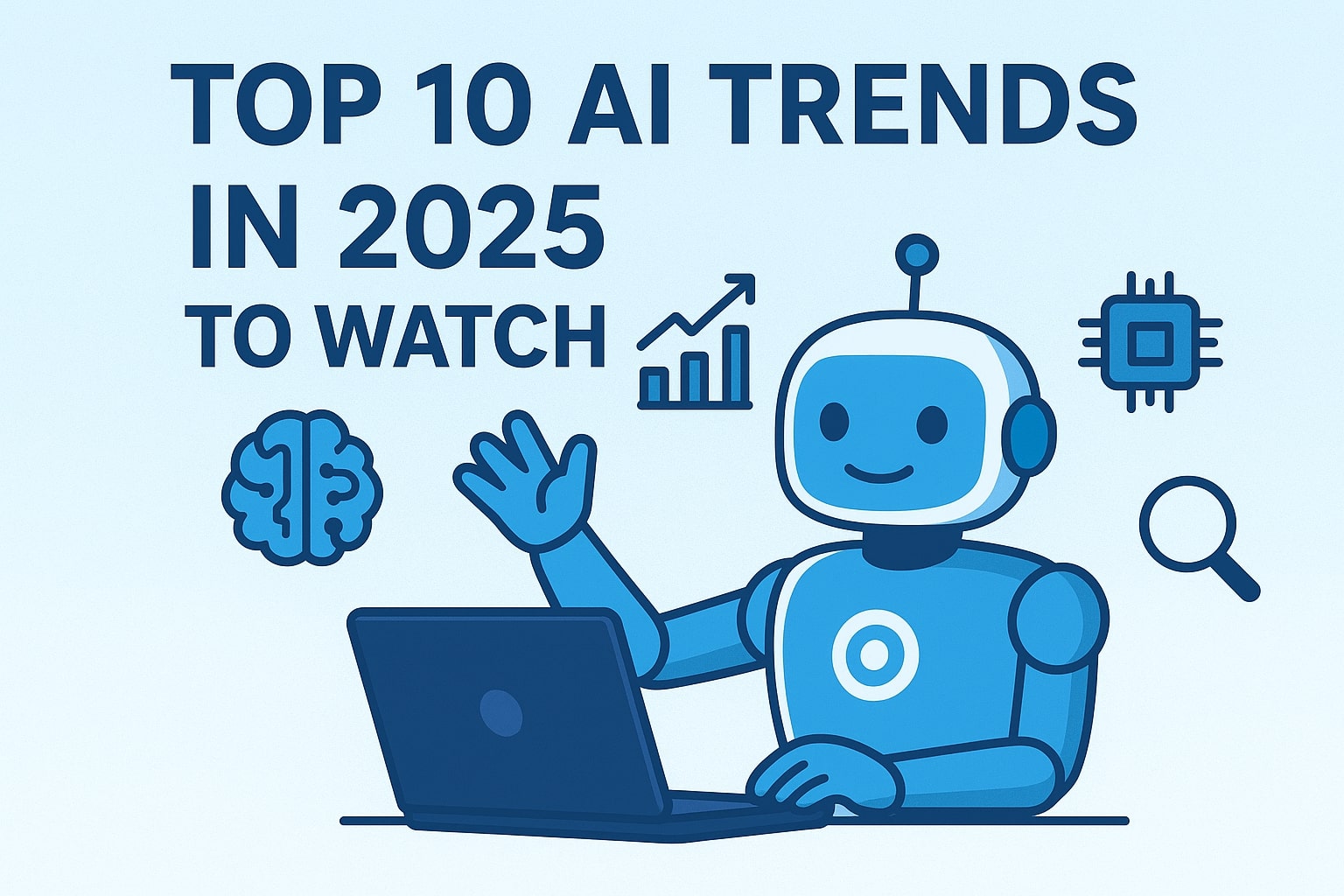Top 10 AI Trends in 2025: What’s Next in Artificial Intelligence
The pace of AI innovation is accelerating. As we move through 2025, new artificial intelligence trends are moving from research labs into real-world applications, reshaping industries and redefining possibilities. Here are the top 10 AI trends you need to know about this year.
1. Agentic AI: The Rise of Autonomous Digital Employees
AI is evolving from a passive tool into an active “agent” that can autonomously plan and execute multi-step tasks. Think of an AI that doesn’t just write an email but can also book a flight, update your calendar, and notify your team—all by itself. This is one of the most impactful AI trends for productivity.
Impact: Will automate complex workflows, becoming a true digital employee.
Outbound Link: Read about the future of autonomous AI agents (McKinsey).
Suggested Image Alt Text: “Visualization of an autonomous AI agent managing a complex digital workflow, a key AI trend for 2025”
2. Multimodal AI: Blending Text, Image, and Sound
The lines between data types are blurring. Multimodal AI models are a major trend, capable of understanding and generating content across text, image, audio, and video seamlessly within a single prompt, leading to richer and more intuitive interactions.
Impact: Richer content creation and more intuitive human-computer interaction.
Outbound Link: See OpenAI’s GPT-4o as an example of multimodal AI.
Suggested Image Alt Text: “Diagram showing multimodal AI processing text, image, and audio simultaneously”
3. Small Language Models (SLMs): Efficient and Specialized AI
Not every task requires a giant model. The rise of Small Language Models (SLMs) is a key 2025 trend, offering efficient, specialized models that run on local devices, providing greater speed, privacy, and customization for specific business use cases.
Impact: Democratizes AI access and enables specialized on-device applications.
Outbound Link: Learn about the benefits of small language models (MIT Tech Review).
Suggested Image Alt Text: “Graph comparing the size and efficiency of small language models vs large language models”
4. AI-Native Hardware: The New Chips Powering Innovation
The industry is moving beyond general-purpose GPUs. The rise of Neural Processing Units (NPUs) and other AI-native chips is a critical trend, designed from the ground up for AI workloads, leading to massive gains in efficiency and performance from data centers to personal devices.
Impact: Faster, cheaper, and more accessible AI processing power.
Outbound Link: Explore NVIDIA’s AI-specific hardware platforms.
Suggested Image Alt Text: “Close-up of a dedicated AI neural processing unit (NPU) chip on a circuit board”
5. Generative Video: AI’s Breakthrough in Motion
Following the explosion of image generation, AI video is having its breakthrough moment. This trend sees tools generating high-fidelity, consistent video clips from text prompts, revolutionizing content creation. Many of the top AI companies are investing heavily here.
Impact: Dramatically lowers the barrier to high-quality video production.
Outbound Link: See an example of AI video generation with Synthesia.
Suggested Image Alt Text: “AI-generated video clip showing a realistic human avatar, representing generative video trends”
6. AI for Science (AI4Sci): Accelerating Discovery
Using AI for scientific discovery is a growing trend. It’s becoming a foundational tool to accelerate drug discovery, design new materials, predict climate patterns, and unravel complex systems in physics and biology, pushing the boundaries of research.
Impact: Accelerates the pace of scientific discovery and innovation.
Outbound Link: Learn how DeepMind’s AlphaFold is revolutionizing biology.
Suggested Image Alt Text: “Scientist using an AI interface to model a complex protein structure for drug discovery”
7. AI Governance: Building Responsible and Ethical Frameworks
As AI becomes more powerful, the push for robust regulation intensifies. This trend will see concrete global frameworks around AI ethics, transparency, and accountability move from theory to practice for organizations worldwide in 2025.
Impact: Builds necessary trust and safety, shaping responsible AI development.
Outbound Link: Review the White House Blueprint for an AI Bill of Rights.
Suggested Image Alt Text: “Scales of justice balancing an AI chip and a globe, symbolizing AI ethics and governance”
8. Generative AI as a Creative Collaborator
AI is shifting from a content creator to a creative partner. This trend involves using AI for brainstorming, mood boarding, prototyping, and iterating on ideas, augmenting human creativity rather than replacing it across all creative fields.
Impact: Enhances creative workflows across design, architecture, music, and marketing.
Outbound Link: Discover Adobe’s generative AI tools for creatives.
Suggested Image Alt Text: “Designer collaborating with an AI interface on a digital mood board”
9. Hyper-Personalization: The AI Tailoring Everything
AI is enabling personalization at an unprecedented scale. This trend sees AI tailoring dynamically generated learning materials, unique shopping experiences, and individualized health plans to a single user’s precise needs and context.
Impact: Transforms user experience in education, e-commerce, and healthcare.
Outbound Link: See how Salesforce Einstein enables hyper-personalization.
Suggested Image Alt Text: “Smartphone screen showing a highly personalized shopping app experience powered by AI”
10. AI-Powered Cybersecurity: The Adaptive Digital Shield
In the endless cat-and-mouse game of digital security, AI is becoming the ultimate weapon. This trend focuses on defensive AI that can predict, detect, and neutralize threats in real-time, adapting to new attack vectors instantly.
Impact: Creates more adaptive and resilient defense systems against increasingly sophisticated threats.
Outbound Link: Explore Darktrace’s AI-powered cybersecurity platform.
Suggested Image Alt Text: “Network security visualization showing AI identifying and neutralizing cyber threats in real-time”
Conclusion: The Integration of AI into Everything
The unifying theme of these top AI trends for 2025 is a shift from experimentation to deep integration. Artificial intelligence is becoming more capable, personal, and seamlessly woven into the fabric of our digital and physical lives. Staying informed on these trends is crucial for any business or individual looking to leverage the best AI tools and strategies.
